calsfoundation@cals.org
Elvis Presley (Arkansas Performances of)
Elvis Presley started his meteoric musical career in 1954 in Memphis, Tennessee, recording for Sam Phillips’s Sun Records. His style of music—combining country (called hillbilly in those days), gospel, blues, pop crooning, and rhythm and blues with his unique singing and dancing talents—can truly be said to have originated a particular brand of rock ‘n’ roll later dubbed rockabilly by music critics and DJs. His music career blossomed a second time in 1968 when he made a comeback after several years in the Hollywood doldrums. His second rise to fame and fortune continued until his death at his Graceland estate in Memphis on August 16, 1977, at the age of forty-two.
Elvis’s presence in Arkansas has three general phases. First is his time as a handsome young singer with his own style and dance moves mainly traveling with his combo within driving distance of Memphis. Second is his time at Fort Chaffee in Barling (Sebastian County), where he was inducted into the U.S. Army in the spring of 1958. Third is his appearance in Jasper (Newton County) with his fiancée at her grandfather’s funeral in 1977 a few months before his death.
Elvis and his combo, called the Blue Moon Boys after their regional hit “Blue Moon of Kentucky” by Bill Monroe, consisted of Elvis (vocals and rhythm guitar), Scotty Moore (lead guitar), Bill Black (standup bass), and D. J. Fontana, who joined the combo as drummer in October 1954. The combo often performed in Arkansas until RCA bought Elvis’s contract from Sam Phillips of Sun Records in November 1955 for $35,000 plus $5,000 to pay back royalties the label owed to Elvis, a hefty sum in those days.
A teenage Elvis played at the Grand Ole Opry in Nashville, Tennessee, on October 2, 1954; this marked his only Opry appearance, as he was not well received, especially by the Nashville old guard, who saw him as a threat. He was told to go back to driving a truck. However, Elvis found early success on the radio/television program Louisiana Hayride, where he appeared on several occasions from 1954 to 1956. He also enjoyed regional success from recordings on the Sun label, especially “That’s All Right, Mama,” “Blue Moon of Kentucky,” “Mystery Train,” and “Baby, Let’s Play House.”
The combo’s Arkansas tours included a swath of Arkansas, especially the eastern half, performing at high school gymnasiums, in auditoriums, on football fields, at National Guard armories, atop flatbed trailers, and in clubs referred to in those days as honky tonks. Elvis visited Arkansas more than forty times between 1954 and 1977. In late 1954, 1955, and early 1956, Elvis and his combo traveled the Rock ‘n’ Roll Highway, a segment of U.S. Highway 67 running approximately 111 miles through Jackson, Lawrence, Randolph, and Clay counties in northeastern Arkansas with a portion in Miller County in southwestern Arkansas.
During the early days of his career, Elvis performed in the following Arkansas locales: Little Rock (Pulaski County), Pine Bluff (Jefferson County), Helena (Phillips County), Leachville (Mississippi County), Augusta (Woodruff County), Aubrey (Lee County), Camden (Ouachita County), Hope (Hempstead County), Newport (Jackson County), Texarkana (Miller County), Parkin (Cross County), Marianna (Lee County), Dermott (Chicot County), El Dorado (Union County), Batesville (Independence County), Bono (Craighead County), Forrest City (St. Francis County), Swifton (Jackson County), and Jonesboro (Craighead County). There may have been others that were not documented. Elvis often played at a location more than one time; for example, he played three times in Little Rock at the Robinson Memorial Auditorium (now the Robinson Center) during his formative years and a fourth time at Barton Coliseum in 1972 during his comeback tours.
The hectic schedule, late nights, and long hours on the road could be hazardous. Three of the band’s vehicles were involved in accidents in Arkansas. Their 1951 Lincoln struck another vehicle at Carlisle (Lonoke County). The band’s first 1955 Cadillac Fleetwood 60 caught fire and burned near Hope, and the second 1955 Cadillac Fleetwood 60 struck another vehicle near Texarkana. This second Cadillac is the famous “pink Cadillac” put on display at Graceland.
In March 25, 1955, Elvis performed at Dermott High School in two shows sponsored by the school. The performance was so controversial that the following day, the superintendent called an assembly where the students were given back their admittance money. (The Dermott admission ticket is one of the earliest known existing tickets showing Elvis as the headline act.) A photograph of Elvis was taken after the show at Coley’s Truck Stop in Dermott, where he was playfully holding Arkansas state trooper Kenneth McKee’s service weapon; local disc jockey Doug Ward is also in the photo.
Elvis’s most memorable flop in the state was on August 6, 1955, when the trio—Elvis, Moore, and Black—performed at the twelfth annual White River Water Carnival on a makeshift dock stage at an outdoor stadium in Batesville. Though he was loved by the youth, especially teenage girls, some of the older townspeople, many of whom were used to the pop music of the day, disapproved of Elvis’s gyrating hip movements.
Local promoter Ed Lyon, with backing from other civic leaders of the town, complained by mail to Colonel Tom Parker, one of Elvis’s managers, saying that Elvis was guilty of unprofessional conduct, told off-color jokes, and then “stormed off the stage” after singing only four songs, thereby “ruining” the show for everybody. Lyon closed the letter by demanding an “adjustment.” Parker quickly sent a refund of $50 and hastily wrote Bob Neal, the co-manager, a scathing note lecturing him that Elvis was “young, inexperienced, and it takes a lot more than a couple of hot records in a certain territory to become a big-name artist.” Some think that Parker could have been initiating a coup to take sole management of Elvis, cutting Neal of Memphis loose by discrediting him, perhaps orchestrating the failure of the appearance without the knowledge of Elvis, Moore, and Black.
Elvis approached the manager of the popular Cotton Club in Trumann (Poinsett County) to arrange a playing date for the combo, but he was turned away and reprimanded: “You’re never going to get anywhere acting that way on stage.”
Elvis’s popularity may have suffered a setback in Dermott and Batesville, but elsewhere in the state Elvis was on his way to becoming the King of Rock ‘n’ Roll. On September 6, 1955, Elvis, Moore, and Black performed in Bono, and so many fans attended the show that the high school gym floor collapsed. No one was hurt.
Elvis and his combo played at the Silver Moon in Newport, a popular honky tonk on the Rock ‘n’ Roll Highway, twice in 1955. On October 24, 1955, Elvis and his combo performed for the second time at the Silver Moon. The combo joined Sonny Burgess and the Moonlighters, who started recording for Sun Records in 1956 as Sonny Burgess and the Newport Pacers. The local newspaper and posters promoted the show this way: “If you like GOOD Western Music (and who doesn’t) You’ll enjoy Elvis Presley and the Moonlighters singing and playing your favorite western tunes, 9 till…”
Elvis, Moore, and Black played at the Swifton High School Gymnasium and at Bob King’s B&I Club on December 9, 1955. As Bob King quipped in a 2008 interview with Lacy Mitchell, Elvis “was friendly. Jerry Lee Lewis was the silly one.” King recalled that he had to get the piano strings replaced every time Lewis played at the club. That night in Swifton, Johnny Cash opened for Elvis. Elvis had signed with RCA the month before (November 21, 1955), so this performance was one of his last in Arkansas before he headed for Las Vegas and Hollywood. Bob King recollected, “Elvis sings ‘Heartbreak Hotel’ and declares, ‘It’s gonna be my first hit.’”
One of Elvis’s first girlfriends was Bonnie Brown of Sparkman (Dallas County), a member of a popular musical trio with her brother, Jim Ed, and sister, Maxine. As the Browns, the trio had a series of hits in the 1950s, culminating in one of the most popular songs of the decade, “The Three Bells,” from 1959. Elvis and the Browns did several shows together in 1954 and 1955.
Elvis was inducted into the U.S. Army as a private at Fort Chaffee near Fort Smith (Sebastian County). He got a medical physical and then received his famous U.S. Army regulation crewcut from head barber James “Pete” Peterson of Roland, Oklahoma, at the Chaffee Barbershop. The barbershop was made into a museum.
Following his discharge in 1960 after two years in the army, Elvis began spending more time making movies in Hollywood under Parker’s tutelage, no longer concentrating on acting but instead appearing in throwaway musicals that were successful at the box office but not as pleasing to his music fans, who were turning to the folk music of Bob Dylan and to the “British Invasion” groups such as the Beatles and the Rolling Stones. Then, on December 3, 1968, Elvis made a runaway comeback when his television special aired on the NBC network. The performance showed the world he was still a master showman who had kept up with changing trends in the music industry. Following the success of his TV appearance, he once again had top hits such as “Suspicious Minds” and “Burning Love.”
His highly successful tours covered the nation, but he performed in Arkansas only twice more. On April 17, 1972, Elvis returned to Barton Coliseum in Little Rock to a sell-out audience of appreciative fans. Elvis’s last performance booking in the state was on September 7–8, 1976, in Pine Bluff at the newly constructed convention center. Returning to his roots, Elvis performed partly to help the new center, which was having a difficult time attracting big-name acts, survive financially. Tickets were $12.50 each, with both nights sold out early. It is said that scalpers were getting $325 per ticket. The Courier News stated that Elvis received $250,000 for the two nights.
Elvis did dubbing and studio work at Wayne Raney and Zyndall Raney’s Rimrock recording studios in Concord (Cleburne County) in the early 1970s. He flew to the Batesville Regional Airport at Southside (Independence County) and slipped into Concord at night unbeknownst to the media.
On January 3, 1977, Elvis and his fiancée, Ginger Alden, along with a fifteen-man entourage, attended the funeral of Alden’s grandfather, William Alonzo Spencer, at the Mount Sherman Assembly of God Church near Jasper. Elvis had Alden’s family flown in to Harrison (Boone County), where they drove twenty miles to Jasper for the services. Elvis used Alden’s white Lincoln Continental during this twenty-four-hour visit. The local newspaper reported, “The Star Is Seen Barely and Briefly.” On August 16 of that same year, Alden found Elvis’s lifeless body upstairs at Graceland.
For additional information:
Brosius, Jeanni. “Zyndall Raney.” Arkansas Democrat-Gazette, Three Rivers Edition, October 16, 2011. Online at http://www.arkansasonline.com/news/2011/oct/16/zyndall-raney-20111016/?threerivers (accessed November 20, 2020).
Brown, Maxine. Looking Back to See: A Country Music Memoir. Fayetteville: University of Arkansas Press, 2009.
Marcus, Greil. Mystery Train: Images of America in Rock and Roll Music. 5th ed. New York: Plume, 2008.
Mitchell, Lacy. “Bob King Dies at 83.” Batesville Daily Guard, July 16, 2008.
Oswald, Mark. “Elvis’ Ties with Arkansas Spanned Career.” Arkansas Democrat, August 17, 1977, p. 3A.
Pasmore, Victoria Micklish. Stars of the Rock ‘n’ Rock Highway. Little Rock: Plum Street Publishers, 2016.
Schwartz, Marvin. We Wanna Boogie: The Rockabilly Roots of Sonny Burgess and the Pacers. Little Rock: Butler Center Books, 2014.
Kenneth Rorie
Van Buren, Arkansas
 Silver Moon Club
Silver Moon Club World War II through the Faubus Era, 1941 through 1967
World War II through the Faubus Era, 1941 through 1967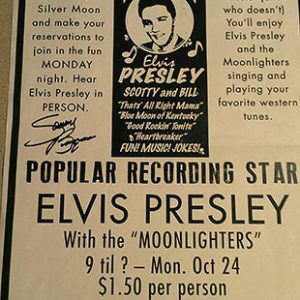 Moonlighters Poster
Moonlighters Poster 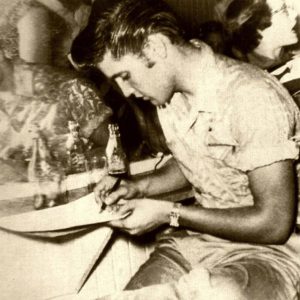 Elvis Presley
Elvis Presley 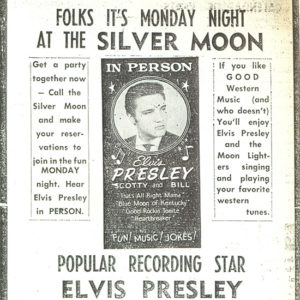 Elvis Presley Ad
Elvis Presley Ad 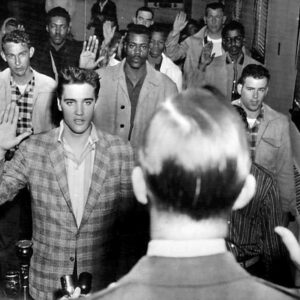 Elvis Presley Induction
Elvis Presley Induction 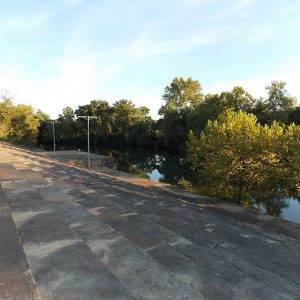 White River Stadium
White River Stadium 




Comments
No comments on this entry yet.